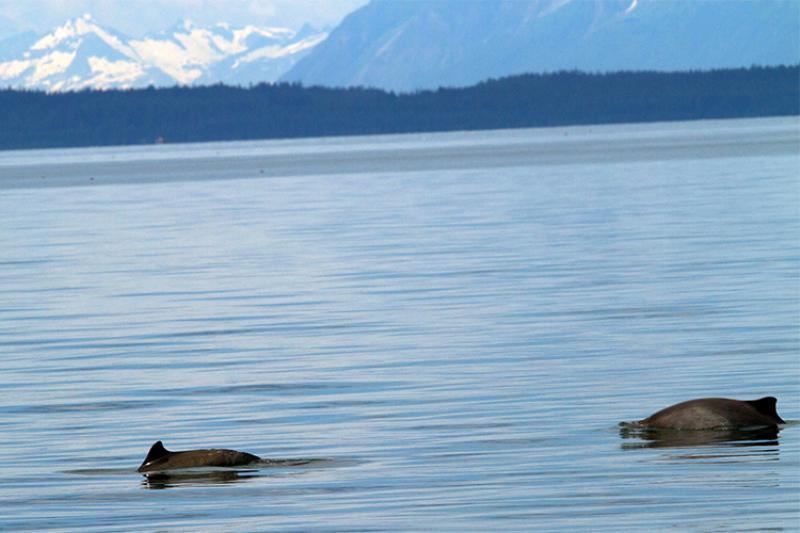
Harbor Porpoises in Southeast Alaska consist of at least two populations
by NOAA Fisheries 24 Dec 2022 23:46 UTC

Two harbor porpoises swimming in waters of Southeastern Alaska © NOAA Fisheries
Scientists produced first abundance estimates for the newly identified populations and assessed potential impacts from gillnet fishing.
New genetic information and other data suggest that in Southeast Alaska, there are two populations of harbor porpoise in inland waters. Scientists also were able to estimate abundance for these two populations using data collected during a 2019 vessel survey and other information.
They estimated that the Northern Inland Waters Southeast Alaska population consists of approximately 1,619 porpoises. The Southern Inland Waters Southeast Alaska population is around 890 porpoises.
Environmental DNA Helps Define Population Structure
Currently, harbor porpoises in Southeast Alaska are managed as a single stock under the Marine Mammal Protection Act.
Scientists examined information from recent genetics studies (including tissue and environmental DNA), survey data, distribution patterns, and trends in abundance. They now have evidence that harbor porpoise in Northern Southeast Alaska inland waters are different from those found in Southern Southeast Alaska inland waters.
Scientists identified two inshore harbor porpoise populations:
- A northern population, which includes areas around Glacier Bay, Icy Strait, and Cross Sound
- A southern population, which includes the area near Zarembo Island and Wrangell, Alaska
Based on what is known about harbor porpoise stock structure in other areas of North America, it is possible that additional populations of harbor porpoise exist in Southeast Alaska, particularly in Yakutat Bay, and along the outer coast and offshore waters. However, current data and analyses are insufficient to delineate units within this area at this time. Until additional information is available, scientists proposed grouping these remaining harbor porpoises into a single unit called the Yakutat/Southeast Alaska Offshore Waters unit.
New Insights on Harbor Porpoise Distribution
"When we look at the collective body of research over time, we have been able to identify key areas where harbor porpoises have been consistently found and other areas where distribution has been variable or harbor porpoises have rarely or never been seen," said Alexandre Zerbini, NOAA affiliate with the Cooperative Institute for Climate, Ocean, and Ecosystem Studies, University of Washington.
For instance, scientists observed high concentrations of harbor porpoise during their 2019 survey. That was consistent with observations between the early 1990s and early 2010s in waters near Cross Sound, Glacier Bay, Icy Strait and around Zarembo and Wrangell Islands during the spring, summer and fall.
In other areas, such as Frederick Sound, the concentration of harbor porpoise is variable across years. For example in 2019, porpoise were seen in Frederick Sound in relatively large numbers, especially close to shore. However, in previous years, the concentration was low despite high survey effort.
"We also found that, over the years, few—if any—harbor porpoises were observed in lower Chatham Strait," said Zerbini.
In the area around Lynn Canal, scientists have also observed variable abundance over the years. Harbor porpoises were regularly observed in this region during research surveys in the 1990s. The region was not sampled during later surveys in the mid-2000s and in 2010. In 2019, scientists observed a small number of groups of harbor porpoises in the area.
Areas of Further Research for Harbor Porpoise
Scientists also suspect that, for at least one of these populations, fisheries bycatch may pose a conservation concern. This is because harbor porpoises, one of the smallest dolphin species, prefer coastal habitats. As a result, they are particularly vulnerable to bycatch in gillnets, pollution, and other types of human disturbance, such as underwater noise.
Several studies have shown that harbor porpoises are highly vulnerable to mortality in gillnet fisheries in the north Atlantic and Pacific oceans. Any gillnet fisheries in Alaska that overlap with harbor porpoises may pose a conservation concern.
That includes the salmon drift gillnet fishery in parts of the Southeast Alaska inland waters, notably Lynn Canal, Taku/Snettisham and Stephens Passage, near Petersburg, Wrangell, Zarembo, Ketchikan, and in portions of Clarence Strait. There is no current estimate of bycatch for all regions where the fishery operates. However, the best available data collected by independent fisheries observers suggests that bycatch mortality in the Southern Southeast Alaska Inland Waters population may pose a conservation risk to the population.
Additional data are also needed to assess the status of harbor porpoise in the Northern Southeast Alaska Inland Waters population and the Yakutat/Southeast Offshore Waters population.
"We don't have abundance estimates for Southeast Alaska offshore waters," said Kim Goetz, co-author and marine mammal biologist, Alaska Fisheries Science Center. "Previous aerial surveys have shown that harbor porpoises occur on the continental shelf west of the Southeast Alaska inland waters. However, we need further surveys of offshore waters and to collect additional genetic information to learn more about stock structure, abundance, and potential relationships with inshore populations."
Scientists will use data from this study, together with the new genetic analyses and other information, to further evaluate harbor porpoise stock structure and status. They will also use it to prepare the draft 2022 stock assessment report, which is expected to be available for public review and comment soon.
And, as a next step, the Alaska Fisheries Science Center is planning to coordinate with the Alaska Department of Fish and Game and the commercial fishing industry to scope out the design and implementation of an observer program for state-managed fisheries that overlap with harbor porpoise in inland waters of Southeast Alaska.